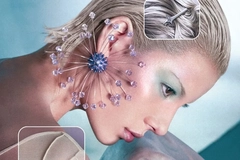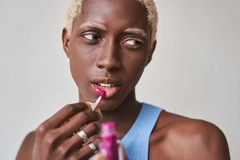Children’s care trends: Parents seek natural ingredients supporting development

Children’s personal care trends are shifting toward a holistic approach that prioritizes natural ingredients. Parents are becoming increasingly informed about ingredients, and demand products that support children’s development.
Personal Care Insights speaks with Karina Ribeiro, R&D global head of Essential Health at Kenvue, and Dr. Kami Hoss, dentist and founder of SuperMouth. They tell us about the latest trends in children’s skin care and oral health, such as solutions that support overall health.
“In today’s children’s personal care market, we are witnessing significant trends driven by parents’ growing concerns for safety and natural ingredients, with 85–90% prioritizing product safety and over 75% influenced by ingredient transparency,” says Ribeiro.
Hoss adds: “There is growing interest among parents in ‘clean’ or ‘natural’ personal care products, and that’s a promising sign. But the challenge is that that trend comes with a lot of misinformation and confusion.”
“A good example is the fluoride debate. More and more parents are choosing non-fluoride options, which is their right, but what’s often overlooked is what’s actually in the alternative.”
Need for parental awareness
Hoss emphasizes the importance of ingredient literacy and informing consumers about what they are buying. He says that ingredients in children’s oral care should support development, rather than just clean the mouth.
Talking about “fluoride-free” solutions, Hoss says: “It’s like buying a product labeled ‘non-broccoli’ or ‘non-chicken’ without knowing what you’re eating instead. It doesn’t make sense to choose a toothpaste just because it doesn’t have fluoride, without understanding what it does contain and how those ingredients work.”
He says that if fluoride is removed from toothpaste, it needs to be ensured that the product includes something that helps with remineralization. The SuperMouth founder stresses that minerals do not work independently.
 Moisturizing agents are crucial for hydration, details Kenvue.Hoss exemplifies nano-hydroxyapatite, as it mimics the structure of natural tooth enamel and helps rebuild it. He says that vitamin D3 helps the body absorb calcium, and K2 helps direct the calcium to where it’s needed, such as bones and teeth.
Moisturizing agents are crucial for hydration, details Kenvue.Hoss exemplifies nano-hydroxyapatite, as it mimics the structure of natural tooth enamel and helps rebuild it. He says that vitamin D3 helps the body absorb calcium, and K2 helps direct the calcium to where it’s needed, such as bones and teeth.
“The trend we need to see is ingredient literacy. Parents already do this when they read nutrition labels and consider what proteins, sugars, and vitamins do for their child’s body. It’s time we take the same approach to oral care products,” says Hoss.
“Most products still include ingredients that are too harsh, too weak, or simply irrelevant. Even many ‘natural” products contain essential oils that may smell nice but can disrupt the oral microbiome.”
“Peppermint oil, for example, is commonly added to create an intense minty and burning sensation that gives the illusion of cleanliness or effectiveness, but it can wipe out beneficial bacteria and compromise the oral microbiome.”
Hoss stresses that, especially for young children, it can trigger severe reactions and has been associated with life-threatening breathing problems. Conventional products often focus on one active ingredient, leaving out essential supporting nutrients.
Moving on to biotics, Hoss says prebiotics are also overlooked.
“Unlike antimicrobials, which try to wipe out all microbes in the mouth, prebiotics support the good bacteria. Inulin, a natural fiber, helps feed beneficial microbes, and xylitol helps reduce acid-producing bacteria while promoting balance in the oral ecosystem.”
“This is especially important in children, whose oral microbiomes are still evolving and maturing, especially in the first few years of life. Our job is not to kill everything in the mouth, it’s to create the right environment for good microbes to thrive,” says Hoss.
Technology and sustainability
The children’s care sector is witnessing technological advancements prioritizing performance and sustainability.
“One of the most notable trends is the emergence of microbiome-friendly formulations designed to support and maintain healthy skin microbiomes in children. Additionally, time-release moisturizing technology is gaining traction, featured in 32% of new industry product launches, offering extended hydration for sensitive skin,” says Ribeiro.
For dental care, Hoss explains how technological advancements in the materials and formulation space are supporting children's oral health.
“There are now bristle technologies that remove far more plaque without harming enamel, critical for children whose enamel is thinner and more vulnerable. We’re seeing ingredient delivery systems that improve how active ingredients reach the teeth and tissues that need them most.”
Arguing that technology is making oral care more engaging, Hoss explains that augmented reality, music-based brushing routines, and gamified solutions are helping children stick to healthy habits. “When combined with the right products, these tools can make a real difference in outcomes.”
 Ribeiro details that adopting biodegradable materials in children’s personal care products has surged by 37%.Ribeiro adds that the adoption of biodegradable materials in children’s personal care products has surged by 37%, particularly in wipes and packaging, reflecting a growing commitment to eco-friendly practices.
Ribeiro details that adopting biodegradable materials in children’s personal care products has surged by 37%.Ribeiro adds that the adoption of biodegradable materials in children’s personal care products has surged by 37%, particularly in wipes and packaging, reflecting a growing commitment to eco-friendly practices.
She says that developing water-saving formulations, including reusable and refillable options to reduce virgin plastic usage, showcases the industry’s dedication to reducing environmental impact without compromising efficacy.
“These advancements not only improve product quality but also align with the increasing demand for sustainable solutions among consumers,” says Ribeiro.
Addressing children’s skin
Modern moisturizing formulas are emerging to meet the special needs of children’s skin.
Ribeiro says that age-specific formulations are becoming vital, with 77% of parents choosing different products for their children at various developmental stages. She adds that products tailored for teenagers are experiencing notable growth.
“Convenience is key, with 78% of parents willing to invest in multifunctional products that simplify their routines. The rise of premium and specialized items, particularly for sensitive skin, also reflects an increasing demand for quality and efficacy,” she says.
Kenvue uses glycerin, caprylic or capric triglyceride, and shea butter in its children’s skin products.
“Barrier support is strengthened with panthenol and oat oil, essential for protecting against environmental stressors. Soothing ingredients such as aloe vera and oat extract are also gaining traction for their calming properties. Natural ingredients like coconut oil and oat continue to be popular, reflecting a shift toward gentle, effective formulations,” continues Ribeiro.
“Vitamins like B and E are also key players, providing antioxidant benefits and overall skin health. This comprehensive approach ensures that children’s personal care products prioritize safety and efficacy.”
Products in focus
Hygiene and skin-protecting products are driving the industry. Essential toiletry products such as baby wipes are at the forefront of the market, closely followed by bath/shower items, skin care products, and moisturizers, according to Kenvue.
 Water-resistant products are the top trend in baby care during the warmer months.Ribeiro says: “These categories are crucial for parents working to keep their children clean and comfortable daily. Hair care products are also increasingly important as the demand for tailored solutions grows to meet the diverse needs of children’s hair types.”
Water-resistant products are the top trend in baby care during the warmer months.Ribeiro says: “These categories are crucial for parents working to keep their children clean and comfortable daily. Hair care products are also increasingly important as the demand for tailored solutions grows to meet the diverse needs of children’s hair types.”
She explains that sun care products are also popular, highlighting awareness among parents about the significance of early skin protection and health. “Overall, these products not only address daily hygiene requirements but also lay the groundwork for lifelong care and well-being.”
According to Kenvue, water-resistant products are the top trend in baby care during the warmer months.
Meanwhile, Hoss from SuperMouth details that toothbrushes, toothpaste, floss, and mouthwash remain staples in most homes. But, they are usually chosen based on marketing, brand recognition, flavor, or whether they contain fluoride.
“What is often missing is understanding whether the product matches the user’s specific needs.”
He says that in a family of different age groups, genders, and potential gum diseases, everyone should not use the same toothpaste, yet that is the standard in most homes.
He details that a ten-year-old with cavities might need intensive remineralization support while a teen in braces has to manage plaque and prevent decalcification. A pregnant mom needs safe, non-toxic, hormone-sensitive care, and someone with gum disease requires ingredients that help reduce inflammation and support healing.
“The proof that our current approach to oral care is not working is right in front of us. The most common chronic disease in the US today, one that is almost entirely preventable, is dental disease, the condition that causes cavities,” says Hoss.












